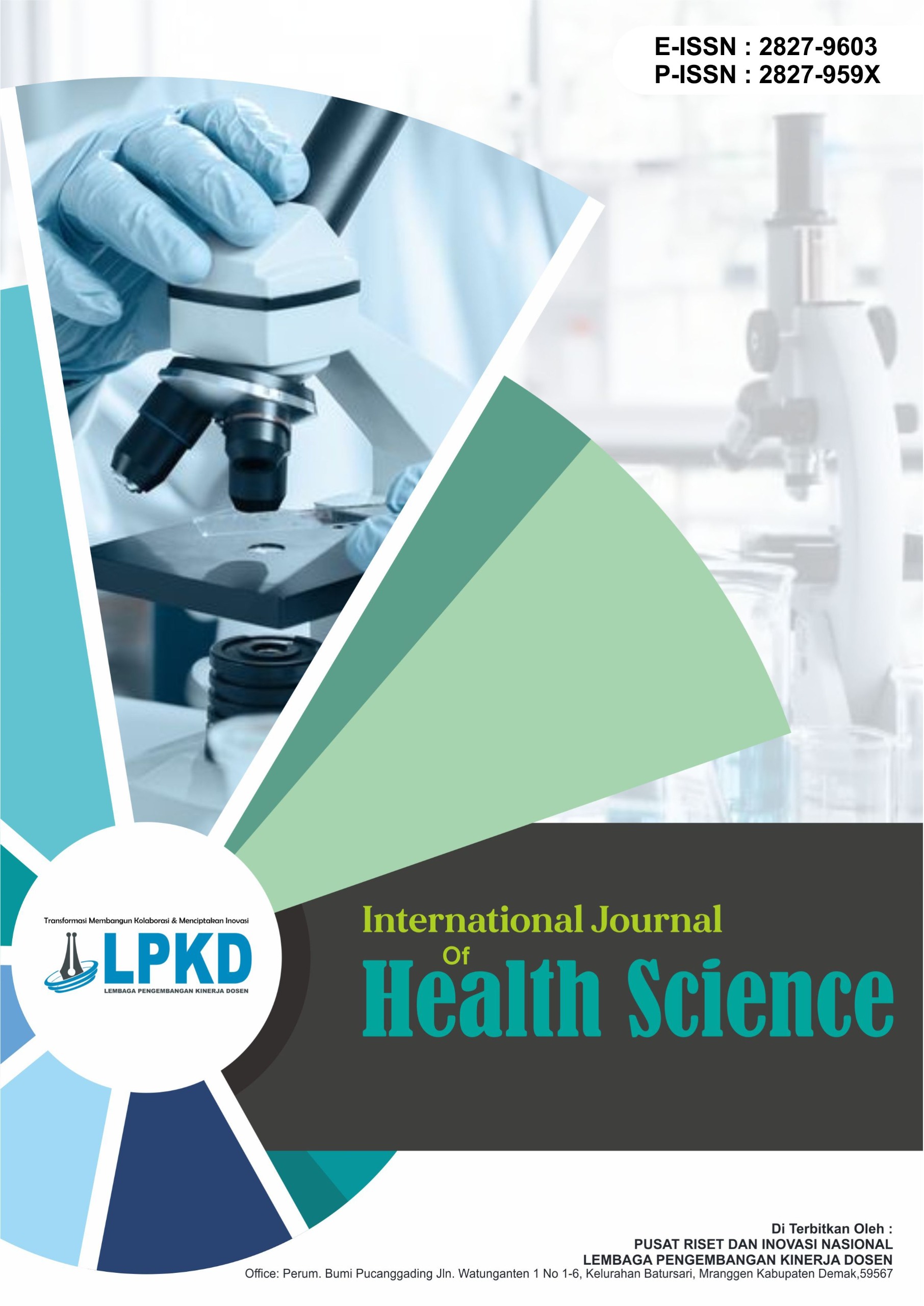The Influence of Pregnant Women's Knowledge Level on High Risk in Pregnancy at PONEK RSU Cut Meutia
DOI:
https://doi.org/10.55606/ijhs.v5i2.5207Keywords:
Knowledge, Pregnant Women, High-Risk PregnancyAbstract
High-risk pregnancy is one of the leading causes of increased maternal and infant morbidity and mortality. Pregnant women's knowledge of healthy pregnancy and danger signs plays a crucial role in preventing and reducing these risks. This study aims to determine the effect of pregnant women's knowledge level on high-risk pregnancy at the Emergency Obstetric and Neonatal Care (PONEK) unit of Cut Meutia General Hospital. This research employed a quantitative design with a cross-sectional approach. The sample consisted of 46 pregnant women selected through purposive sampling. Data were collected using questionnaires and medical record observations. The data were analyzed using the Chi-Square test with a significance level of α = 0.05. The results showed that most pregnant women with low knowledge experienced high-risk pregnancies (75%). The Chi-Square test revealed a significant relationship between knowledge level and the incidence of high-risk pregnancy (p = 0.001). Thus, there is a significant effect of pregnant women's knowledge level on the risk of high-risk pregnancy. Continuous educational efforts by health professionals are needed to improve maternal knowledge and reduce the incidence of high-risk pregnancies.
Downloads
References
[1] American College of Obstetricians and Gynecologists (ACOG), Guidelines for Perinatal Care, 8th ed. Washington, DC: ACOG, 2022.
[2] Badan Perencanaan Pembangunan Nasional (Bappenas), Laporan Kesehatan Ibu dan Anak di Indonesia. Jakarta: Bappenas, 2022.
[3] Black, R. E., Allen, L. H., Bhutta, Z. A., Caulfield, L. E., de Onis, M., Ezzati, M., and Rivera, J., “Maternal and child undernutrition: Global and regional exposures and health consequences,” The Lancet, vol. 382, no. 9890, pp. 243–260, 2020.
[4] Cunningham, F. G., Leveno, K. J., Bloom, S. L., Spong, C. Y., Dashe, J. S., Hoffman, B. L., and Casey, B. M., Williams Obstetrics, 26th ed. New York: McGraw Hill, 2022.
[5] Dekker, G., and Sibai, B., “Primary, secondary, and tertiary prevention of pre-eclampsia,” The Lancet, vol. 393, no. 10178, pp. 63–73, 2019.
[6] Dinas Kesehatan Aceh, Laporan Tahunan Kesehatan Ibu Hamil di Aceh. Banda Aceh: Dinas Kesehatan Aceh, 2022.
[7] Fraenkel, J. R., and Wallen, N. E., How to Design and Evaluate Research in Education, 8th ed. New York: McGraw-Hill, 2012.
[8] Goldenberg, R. L., Culhane, J. F., Iams, J. D., and Romero, R., “Epidemiology and causes of preterm birth,” The Lancet, vol. 371, no. 9606, pp. 75–84, 2020.
[9] Indonesia Ministry of Health, National Guidelines on Maternal Health Services. Jakarta: Ministry of Health, 2023.
[10] Kementerian Kesehatan Republik Indonesia, Profil Kesehatan Ibu dan Anak di Indonesia. Jakarta: Kemenkes RI, 2022.
[11] Manuaba, I. B. G., Ilmu Kebidanan, Penyakit Kandungan, dan Keluarga Berencana untuk Pendidikan Bidan. Jakarta: EGC, 1998.
[12] Nonaka, I., and Takeuchi, H., The Knowledge-Creating Company: How Japanese Companies Create the Dynamics of Innovation. New York: Oxford University Press, 1995.
[13] O’Brien, J. A., Introduction to Information Systems, 17th ed. New York: McGraw-Hill, 2019.
[14] Roberts, J. M., Escudero, C., and Knight, M., “Preeclampsia and pregnancy complications: Risk assessment and management,” Obstetrics & Gynecology, vol. 137, no. 3, pp. 445–458, 2021.
[15] RSU Cut Meutia, Laporan Tahunan Angka Kehamilan Risiko Tinggi di RSU Cut Meutia. Lhokseumawe: RSU Cut Meutia, 2023.
[16] RSU Cut Meutia, Data Statistik Ibu Hamil dengan Risiko Tinggi di RSU Cut Meutia. Lhokseumawe: RSU Cut Meutia, 2024.
[17] Siemens, G., “Connectivism: A learning theory for the digital age,” International Journal of Instructional Technology and Distance Learning, vol. 2, no. 1, pp. 3–10, 2005.
[18] UNICEF, Maternal Mortality: Levels and Trends. New York: UNICEF, 2022.
[19] World Health Organization (WHO), High-Risk Pregnancy: Causes and Management Strategies. Geneva: WHO, 2021.
[20] World Health Organization (WHO), Trends in Maternal Mortality: 2000 to 2021. Geneva: WHO, 2021.
[21] World Health Organization (WHO), Antenatal Care Guidelines: Improving Maternal and Fetal Health Outcomes. Geneva: WHO, 2022.
Downloads
Published
How to Cite
Issue
Section
License
Copyright (c) 2025 International Journal Of Health Science

This work is licensed under a Creative Commons Attribution-ShareAlike 4.0 International License.







